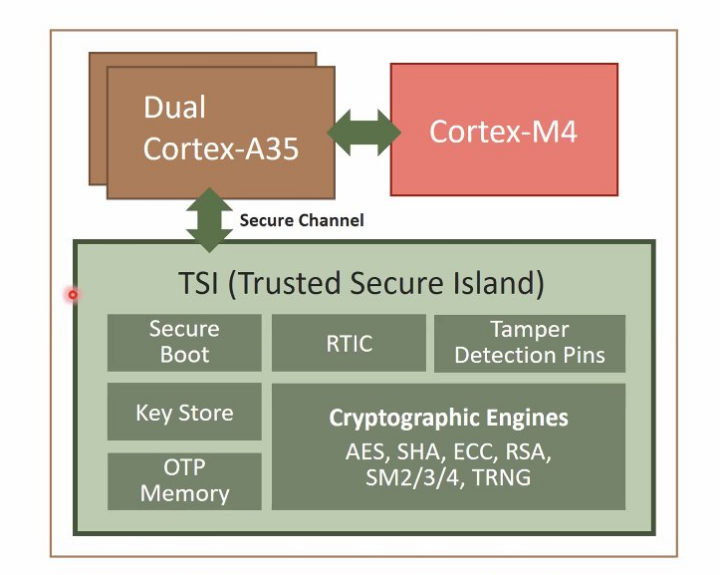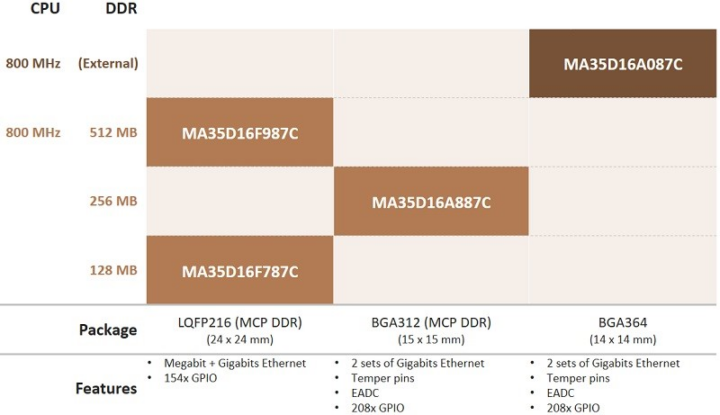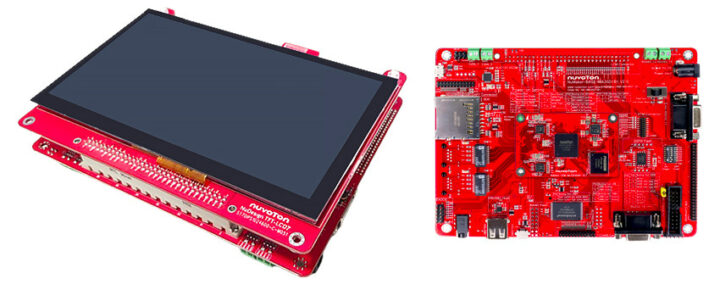Novoton NuMicro MA35D1 microprocessor features two Arm Cortex-A35 cores, one Arm Cortex-M4 real-time core, and two Ethernet interfaces for Linux-based edge IIoT gateway.
The SoC also is offered in variants supporting external DDR memory or integrated up to 512MB RAM, 154 or 208 GPIOs, and an optional “Enhanced ADC”. The MA35D1 also comes with a TFT interface for up to 1920×1080 displays, several hardware security features, and the company says the microprocessor facilitates Tiny AI/ML for edge computing despite not integrating an AI accelerator.

Nuvoton NuMicro MA35D1 key features and specifications:
- CPU sub-system
- 2x Cortex-A35 cores running at up to 800 MHz
- Cortex-M4 real-time core at up to 180 MHz
- Memory sub-system
- On-chip 384 KB SRAM (Cortex-A35 256 KB + Cortex-M4 128 KB)
- Multi-Chip Package (MCP) DDR up to 512MB
- External DDR interface for MA35D16A087C SKU
- Storage
- Quad SPI
- NAND Flash Controller
- Secure Digital Host Controller (SDHC)
- Display and Video Sub-system
- 24-bit RGB TFT-LCD display interface up to 1080p60
- 2D Graphic Engine (GFX)
- H.264 video decoder and JPEG image decoder
- CMOS sensor interface
- Networking
- 2x Gigabit Ethernet MAC (GMAC) OR
- 1x Gigabit Ethernet + 10/100M Ethernet MAC depending on SKU
- USB – USB 2.0 high-speed host and device
- Other peripherals
- Peripheral DMA (PDMA)
- I2C
- Serial – CAN FD, Low-power UART
- Audio – I2S
- Enhanced PWM (EPWM), 32-bit Timer PWM
- Quadrature Encoder Interface (QEI)
- Enhanced Capture (ECAP)
- HMI – KeyPad Interface (KPI), 4/5-Wire Touch
- Enhanced Analog-to-Digital Converter (EADC), Analog-to-Digital Converter (ADC)
- Security
- TrustZone
- Secure Boot
- Trusted Secure Island (TSI) – Run-Time Integrity Checker (RTIC)
- Cryptographic – AES, SHA, ECC, RSA, SM 2/3/4 TRNG
- KeyStore
- One-Time-Program (OTP) Memory
- Tamper Detection Pins
- CMOS Sensor Interface
- Misc – Real-Time Clock (RTC)
- Packages
- LQFP216 (24 x 24 x 1.4 mm, Pitch 0.4 mm)
- BGA312 (15 x 15 x 1.4 mm, Pitch 0.8 mm)
- BGA364 (14 x 14 x 1.4 mm, Pitch 0.65 mm)
- Temperature range – -40 ~ 85°C (Industrial-grade)
The MA35D16A087C and MA35D16A887C SKUs offer two Gigabit Ethernet interfaces, temper pins, EADC, and 208 GPIO pins, with the former taking external DDR memory, and the latter featuring 256MB RAM on-chip. The MA35D16F987C and MA35D16F787C models offer Fast and Gigabit Ethernet interfaces, 154 GPIO pins, and 512MB and 128MB RAM respectively.
Nuvoton offers software and hardware tools to shorten the development time. Linux 5.4 and 5.10 kernel, OpenWrt OS, Yocto and Buildroot build systems, secure firmware, and additional repositories specific to MA35D1 can be found on the company’s GitHub account. The company also provides support for the development of graphical user interfaces based on Qt or LVGL.
Two evaluation boards are available. First, the NuMaker-HMI-MA35D1-S1 with a 7-inch display for HMI applications.
Specifications:
- SoM (NuMaker-SOM-MA35D16A81)
- SoC – MA35D16A8A7C / BGA312 package, stacking a 256MB DDR
- Storage – 16GB flash
- Networking – 2x Gigabit Ethernet PHY
- PMIC
- Display – 7-inch TFT-LCD (1024×600) with 4-wire resistive touch
- Baseboard (NuMaker-BASE-MA35D1B1)
- Storage – SD card slot
- Audio – Audio codec with Mic, Headset Jack
- Camera – 2x Camera interfaces
- Networking – 2x Gigabit Ethernet ports
- USB – 1x USB 2.0 Host, 1x USB 2.0 Host/Device
- Serial – 2x CAN FD, 2x UART, 2x RS485
- Analog – 8x ADC
The second is the NuMaker-IoT-MA35D1-A1 designed for headless applications.
Specifications:
- SoC – NuMicro MA35D16F787C (LQFP216) MCP package with DDR2 (128 MB)
- Storage
- 512MB Quad SPI flash
- 1GB NAND flash
- MicroSD card slot
- Audio – NAU88C22 audio codec with microphone input and speaker output
- Camera – 1x camera interface
- Networking
- 1x Gigabit Ethernet RJ45 port via RTL8211FDI-CG
- 1x 10/100M Ethernet RJ45 port via RTL8201FI-VC
- USB – 1x USB 2.0 Host/Device (HUSB0), 1x USB 2.0 Host
- Serial – RS232 and RS485 headers, CAN FD header
- Debugging
- UART debug port (UART0): USB Virtual COM (VCOM) port
- Debug ports: SWJ (JTAG + SWD) connector
- Expansion
- 40-pin Raspberry Pi header
- Arduino UNO compatible headers
- Misc – Battery header for RTC, DIP switches for system booting selection, 4x buttons, 3x user LEDs
- Power – 5V/2A via power jack, USB VCOM port, or HUSB0 device
I could not find pricing information for the MA35D1 processor and evaluation kits. There’s limited additional information on the product page with no datasheet or documentation that I could see. Beside the GitHub repositories mentioned above, the forums (not rendering properly in Firefox) are one way to ask for more details, and the company uploaded a few videos on YouTube to introduce the microprocessor and show how to get started with the development kits.

Jean-Luc started CNX Software in 2010 as a part-time endeavor, before quitting his job as a software engineering manager, and starting to write daily news, and reviews full time later in 2011.
Support CNX Software! Donate via cryptocurrencies, become a Patron on Patreon, or purchase goods on Amazon or Aliexpress







